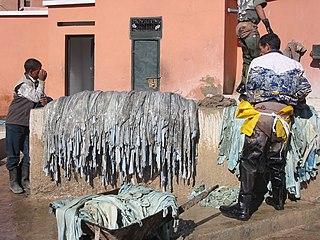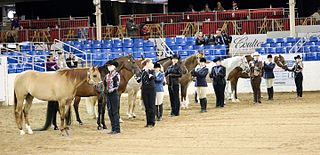
Leather is a strong, flexible and durable material obtained from the tanning, or chemical treatment, of animal skins and hides to prevent decay. The most common leathers come from cattle, sheep, goats, equine animals, buffalo, pigs and hogs, and aquatic animals such as seals and alligators.
A lubricant is a substance that helps to reduce friction between surfaces in mutual contact, which ultimately reduces the heat generated when the surfaces move. It may also have the function of transmitting forces, transporting foreign particles, or heating or cooling the surfaces. The property of reducing friction is known as lubricity.

Tanning, or hide tanning, is the process of treating skins and hides of animals to produce leather. A tannery is the place where the skins are processed.

Cutting fluid is a type of coolant and lubricant designed specifically for metalworking processes, such as machining and stamping. There are various kinds of cutting fluids, which include oils, oil-water emulsions, pastes, gels, aerosols (mists), and air or other gases. Cutting fluids are made from petroleum distillates, animal fats, plant oils, water and air, or other raw ingredients. Depending on context and on which type of cutting fluid is being considered, it may be referred to as cutting fluid, cutting oil, cutting compound, coolant, or lubricant.

Petroleum jelly, petrolatum, white petrolatum, soft paraffin, or multi-hydrocarbon, CAS number 8009-03-8, is a semi-solid mixture of hydrocarbons, originally promoted as a topical ointment for its healing properties. Vaseline has been an American brand of petroleum jelly since 1870.

Linseed oil, also known as flaxseed oil or flax oil, is a colourless to yellowish oil obtained from the dried, ripened seeds of the flax plant. The oil is obtained by pressing, sometimes followed by solvent extraction.

Synthetic oil is a lubricant consisting of chemical compounds that are artificially modified or synthesised. Synthetic lubricants can be manufactured using chemically modified petroleum components rather than whole crude oil, but can also be synthesized from other raw materials. The base material, however, is still overwhelmingly crude oil that is distilled and then modified physically and chemically. The actual synthesis process and composition of additives is generally a commercial trade secret and will vary among producers.

Mink oil is an oil used in medical and cosmetic products. It is obtained by the rendering of mink fat which has been removed from pelts bound for the fur industry.

Dubbin is a greasy or waxy product used to soften, condition, and waterproof leather. It has been used since medieval times to waterproof and soften leather goods. It differs from saddle soap used to clean and lightly condition leather, or shoe polish, which is used to impart shine and colour to it.
Hoof glue is a form of animal glue made by boiling down the hooves of ungulates into partially hydrolyzed keratin. It is not to be confused with hide glue.

Showmanship is an event found at many horse shows. The class is also sometimes called "Fitting and Showmanship", "Showmanship In-Hand", "Showmanship at Halter" or "Halter Showmanship" It involves a person on the ground leading a horse, wearing a halter or bridle, through a series of maneuvers called a pattern. The horse itself is not judged on its conformation. Exhibitors are judged on exhibiting the animal to its best advantage, with additional scoring for the grooming and presentation of both horse and handler.

Animal glue is an adhesive that is created by prolonged boiling of animal connective tissue in a process called rendering. In addition to being used as an adhesive it is used for coating and sizing, in decorative composition ornaments, and as a clarifying agent.
An oil is any nonpolar chemical substance that is composed primarily of hydrocarbons and is hydrophobic and lipophilic. Oils are usually flammable and surface active. Most oils are unsaturated lipids that are liquid at room temperature.

A saddle is a supportive structure for a rider of an animal, fastened to an animal's back by a girth. The most common type is equestrian. However, specialized saddles have been created for oxen, camels and other animals. It is not known precisely when riders first began to use some sort of padding or protection, but a blanket attached by some form of surcingle or girth was probably the first "saddle", followed later by more elaborate padded designs. The solid saddle tree was a later invention, and though early stirrup designs predated the invention of the solid tree, the paired stirrup, which attached to the tree, was the last element of the saddle to reach the basic form that is still used today. Today, modern saddles come in a wide variety of styles, each designed for a specific equestrianism discipline, and require careful fit to both the rider and the horse. Proper saddle care can extend the useful life of a saddle, often for decades. The saddle was a crucial step in the increased use of domesticated animals, during the Classical Era.

Horse grooming is hygienic care given to a horse, or a process by which the horse's physical appearance is enhanced for horse shows or other types of competition.
Saddle soap is a compound used for cleaning, conditioning, and protecting leather. It typically contains mild soap, softening ingredients such as lanolin, and preservatives such as beeswax. It is commonly used on leather footwear, saddles, and other items of horse tack, hence its name.

Crocodile oil is extracted from the fatty tissues of crocodiles. Crocodile fat is a product of commercial farming, evident in Thailand. Historically, for centuries crocodile oil has been used by traditional practitioners across the globe, including Chinese Traditional Medicine, Southeast Asia, Ancient Egypt. Crocodile oil was found to be used since the 19th century for different purposes in different cultures. Due to the oil's components, its richness in monounsaturated and Polyunsaturated fats, it is today commonly used as ointment for treatment of skin conditions, skin structure enhancement, collagen deposition, and medicine for illnesses. In recent times, the use of crocodile oil has invited criticism from the use of crocodile oil as there is an increased demand for cruelty-free and vegan-friendly beauty products in consumers of today's society.

Inksticks or ink cakes are a type of solid Chinese ink used traditionally in several Chinese and East Asian art forms such as calligraphy and brush painting. Inksticks are made mainly of soot and animal glue, sometimes with incense or medicinal scents added. To make ink, the inkstick is ground against an inkstone with a small quantity of water to produce a dark liquid which is then applied with an ink brush. By adjusting the strength and duration of the ink grinding process, artists and calligraphers may adjust the concentration of the produced ink to suit their tastes.
Honing oil is a liquid, solution or emulsion used to aid in the cutting or grinding of metal, typically by abrasive tools or stones, and may or may not contain oil. It can also be called machining oil,tool oil, cutting fluid, and cutting oil.
The conservation and restoration of leather objects is the process of determining the causes of deterioration, followed by deciding the best course of action for preserving the leather objects for the future.














